Small Animals Are Companions to What Percentage of American Families?
Study Highlights. Two out of every three American homes includes a pet, and 393.3 million pets live in the United States; dogs, cats, and fish are the most popular pets, though preferences for breeds and types of animals vary across regions.
- 85 million or 67% of American homes include a pet.
- 95% of American pet owners consider their pets to be family members.
- Freshwater aquarium fish are the most pop pet, with 139.3 one thousand thousand of them nationwide.
- Americans spend $1 billion each year on pet insurance.
- Pet ownership has increased xx% since 1988.
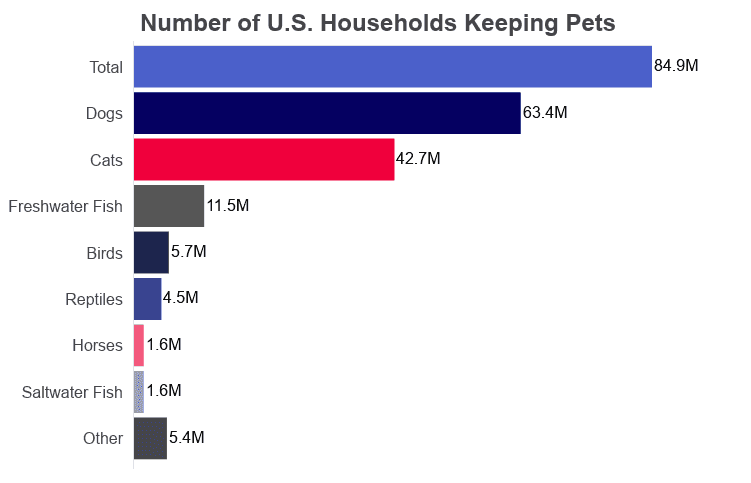
Pet Ownership by State:
AL | AK | AZ | CA | CO | CT | DE | FL | GA | HI | ID | IL | IN | IA | KS | KY | LA | ME | Dr. | MA | MI | MN | MS | MO | MT | NE | NV | NH | NJ | NM | NY | NC | ND | OH | OK | OR | PA | RI | SC | SD | TN | TX | UT | VT | VA | WA | WV
Pet Ownership Statistics
Pet Ownership in the United States has risen steadily in contempo decades, with a higher percentage of households owning pets today compared to twoscore years agone.
-
- 84.9 million or 67% of American households own at least one kind of pet.
- 63.four meg or 53% of American households ain dogs.
- Virtually dog-owning households have 1 dog.
- 42.7 1000000 or 35.seven% of households ain cats.
- Cat owning households go along an boilerplate of 2 cats each.
- 11.5 million or ix.6% of households own freshwater fish.
- Freshwater fish owners keeps an boilerplate of 12 fish.
- v.seven million or 4.8% keep birds.
- Between three and 4 birds live in the boilerplate bird-owning household.
- 4.v million or 3.viii% take reptiles.
- Each reptile-owning households keeps an boilerplate of 2 reptiles.
- 1.6 million or one.3% continue horses.
- Horse owners go on between 4 and 5 horses per household.
- 1.six million or 1.3% keep saltwater fish.
- Households with saltwater fish continue between 11 and 12 fish on average.
- v.4 million or four.5% have another type of small-scale animate being as a pet.
- These households keep between 2 and 3 pets.
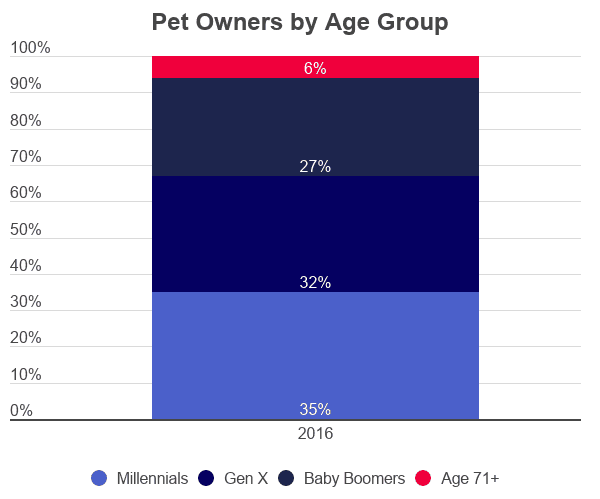
Pet Ownership Among Generations
Pet ownership appears to be most popular amidst younger adults. The eldest of Generation Z are just now reaching adulthood. Wtih comparatively piddling data bachelor regarding Generation Z and pet buying, statistical meaning is doubtful.
-
-
- 73% of Millennials, born between 1981 and 1994, ain pets.
- 89% of home-owning Millennials also own pets.
- 35% of all pet owners are Millennials.
- 32% of pet owners are Generation X, born between 1965 and 1981.
- 27% of pet owners are Baby Boomers, built-in between 1946 and 1964.
- Only 6% of pet owners are in the Silent Generation.
-
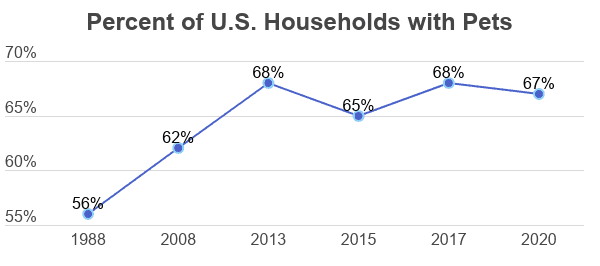
Historical Pet Ownership
While it appears pet ownership amid households has stagnated, in that location are significantly more pet owners now than there were 30 years ago. This increment may be partially explained by the growing number of medical specialists and counselors espousing the health benefits of companion animals.
- There's been a xx% increment in pet buying since 1988, when just 56% of American households owned a pet.
- In the 20 years between 1988 and 2008, petownership increased amidst U.S. households by xi%, or six percentage points.
- In the five years betwixt 2008 and 2013, pet ownership rose 10%, or a farther half dozen per centum points.
- In the 25 years betwixt 1988 and 2013, household pet ownership grew 0.ix% annually.
- Since 2000, dog ownership has risen steadily by 21.9%.
- Cat buying has cycled upwards and down but, overall, has increased 29% since 2000.
- Pet fish ownership has declined 12.4% since 2000.
- Bird owners increased slightly, rising 8.four% between 2000 and 2018.
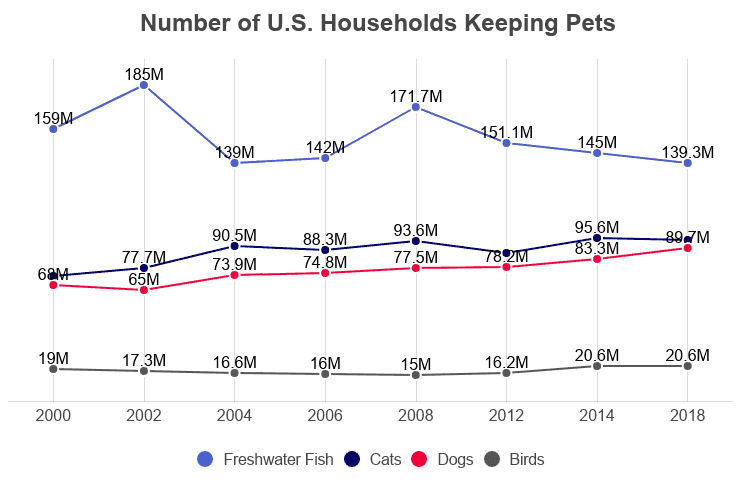
Pet Ownership Among States
Pet buying not only varies across states, but the popularity of different breeds varies from one state to the next. Wyoming's high rate of pet ownership just relatively low rate of canis familiaris and true cat ownership is likely due to the popularity of horses in this region.
- In 80% of states, over one-half of households include at least i pet.
- Wyoming households are the most likely to include pets.
- Households in Montana are the nigh likely to include dogs.
- Households in West Virginia are the nigh likely to include cats.
- Kentucky, Missouri, Mississippi, Alabama, Tennessee, Texas, and Oklahoma are amidst the acme ten states in dog ownership.
- Washington, Kentucky, Indiana, and New Hampshire are amidst the top x states in true cat buying.
- Rhode Island households are the least likely to include cats and the least likely to include any kind of pet.
- Households in Connecticut are the to the lowest degree probable to include a dog.
| Land | % of Pet-Owning Households | |||
|---|---|---|---|---|
| All | Dogs | Cats | ||
| 1 | Wyoming | 71.viii% | 36.0% | xxx.0% |
| 2 | Due west Virginia | lxx.vii% | 50.0% | 38.0% |
| iii | Vermont | seventy.0% | 28.three% | 44.half-dozen% |
| 4 | Idaho | 69.ix% | 33.3% | 34.4% |
| five | Indiana | 69.ii% | 49.4% | 37.5% |
| 6 | Arkansas | 69.0% | 51.vi% | 34.8% |
| 7 | Mississippi | 65.5% | 51.0% | 29.ane% |
| 8 | Oklahoma | 65.0% | 47.vii% | 28.four% |
| ix | Kentucky | 64.ane% | 46.5% | 32.two% |
| ten | North Dakota | 63.seven% | 44.iii% | 24.viii% |
| 11 | Missouri | 63.5% | 45.i% | 32.2% |
| 12 | Maine | 63.5% | 35.9% | 43.6% |
| 13 | Kansas | 62.8% | 43.1% | 32.four% |
| 14 | Washington | 62.vii% | 42.eight% | thirty.five% |
| xv | Ohio | 62.4% | 37.9% | 30.7% |
| 16 | Michigan | 62.4% | 41.nine% | 31.two% |
| 17 | South Carolina | 62.0% | 45.3% | 25.2% |
| 18 | Montana | 61.9% | 51.nine% | 22.8% |
| 19 | Tennessee | 61.seven% | 47.0% | xxx.9% |
| twenty | Pennsylvania | sixty.6% | 38.9% | 28.9% |
| 21 | New Mexico | 60.1% | 39.4% | 25.2% |
| 22 | Hawaii | sixty% | 43% | * |
| 23 | Alabama | 59.viii% | 46.9% | 26.i% |
| 24 | Iowa | 59.4% | 36.3% | 35.half-dozen% |
| 25 | Oregon | 59.2% | 37.8% | xxx.0% |
| 26 | Wisconsin | 59.0% | 33.6% | 32.4% |
| 27 | N Carolina | 58.6% | 41.three% | 26.5% |
| 28 | Utah | 58.5% | 36.2% | 24.7% |
| 29 | Texas | 58.2% | 43.iv% | 26.five% |
| 30 | Arizona | 58.0% | 43.0% | 26.4% |
| 31 | Delaware | 57.9% | 42.2% | 24.1% |
| 32 | Florida | 56.0% | 39.8% | 24.2% |
| 33 | Virginia | 55.5% | 35.6% | 23.9% |
| 34 | Louisiana | 54.4% | 38.3% | 19.0% |
| 35 | Minnesota | 54.0% | 35.5% | 26.5% |
| 36 | Nevada | 53.iii% | 36.eight% | 23.ane% |
| 37 | California | 53.0% | 32.viii% | 28.three% |
| 38 | New Hampshire | 51.8% | 23.seven% | 36.4% |
| 39 | Nebraska | 51.three% | 47.1% | thirty.nine% |
| twoscore | Georgia | 51.one% | 36.7% | xx.iv% |
| 41 | Connecticut | 49.ix% | 24.0% | 26.7% |
| 42 | New York | 49.seven% | 27.0% | 21.ane% |
| 43 | Massachusetts | 49.1% | 28.9% | 23.5% |
| 44 | Maryland | 48.vi% | 30.ii% | 18.6% |
| 45 | Illinois | 48.six% | 32.4% | 18.6% |
| 46 | New Jersey | 47.four% | 29.1% | 18.9% |
| 47 | Colorado | 47.2% | 27.i% | 20.0% |
| 48 | S Dakota | 46.4% | 32.i% | 26.6% |
| 49 | Rhode Isle | 45.4% | 25.eight% | 16.7% |
| Alaska | * | * | * | |
* Data point unavailable.
Exotic Pet Ownership
Typically, the term "exotic pet" refers to any non-domesticated fauna; this excludes animals like republic of guinea pigs and canaries. The definition of an exotic pet varies by locale, then what is considered "domesticated" in ane place may exist considered exotic elsewhere.
- Exotic pets practise not bail with humans the same mode domesticated animals do.
- Certain states ban specific types of pets.
- Many states ban entire classes of animal, such as primates, from existence ketp as pets.
- Other states require special permits for exotic animate being ownership.
| Proper name of Animal | Description | Care Needs | Banned In |
|---|---|---|---|
| Bengal Cat | Smaller than wild cats, have been hybridized with wild and domestic cats | High energy, these cats need everything a "regular" cat does, plus extra practice and mental stimulation. | Alaska, Connecticut, Delaware, Georgia, Hawaii, Indiana, Iowa, Massachusetts, New York |
| Fennec Fox | Small, rodent-like foxes with large ears | Can be crated but need lots of freedom to roam outside. They love to play and relish companionship. | Minnesota, Missouri, Nevada, Washington |
| Hedgehog | Pocket-sized, spiny creature that are neither rodent nor porcupine. | Requires enclosed habitat (similar to guinea pig's) and specialty food | Arizona, California, Georgia, Hawaii, Maine, Pennnsylvania, New York City |
| Skunk | The same blazon of skunk found in the wild, though to exist kept equally pets, they must be de-scented | These animals are happy with a diet composed of dog nutrient, basics, fruits, and vegetables. They love to play, needing lots of do and time outside their enclosure. | Most states have banned skunks, and the ones that haven't unremarkably require special permits for buying. |
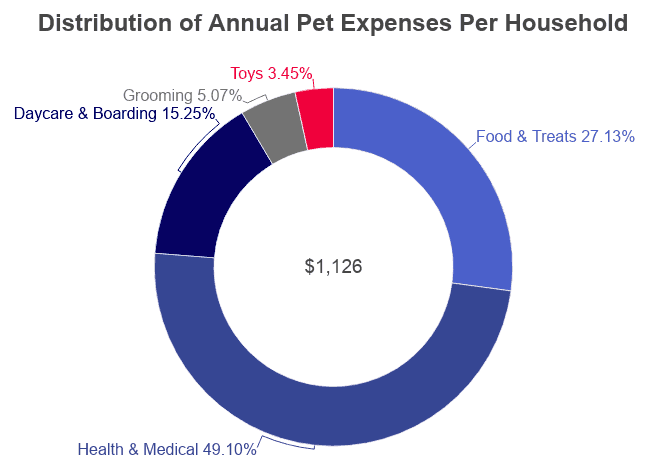
Price of Owning a Pet
The pet industry is one of the largest in the world, with the majority of its $95 billion-dollar value coming from pet food. Historically, spending for pets seems unaffected by the economic system's performance. Pet owner spending has steadily increased in every area except the buy of live animals. The latter data may be owing to increased awareness of creature shelters and the benefits of pet adoption.
- $1,126 is how much the average pet owning household spends on their pets each twelvemonth.
- twoscore% of that budget goes toward food and treats.
- Annual increases in food spending are often linked to specialty and boutique foods as well equally dietary trends.
- 35.7% of annual pet spending goes toward medical and veterinarian intendance.
- Nigh pet healthcare procedures cost more for dogs than cats.
- 68% of dog owners say they would keep their pet intendance spending the same no matter what happens with the economy.
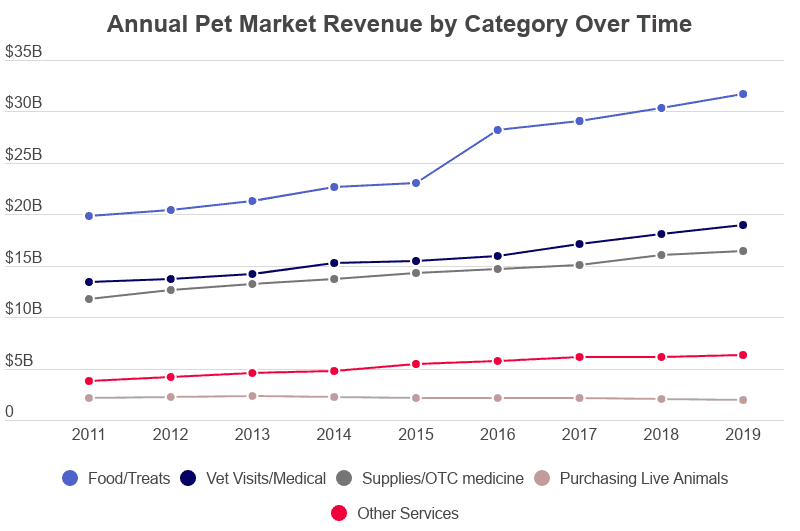
Cost of Pet Insurance
The pet insurance industry is relatively new in the United States, but information technology appears to be on the ascent. Competative companies now offer pet insurance as office of employee benefits packages.
- i.6% of American pet owners have pet insurance.
- 81% of all policies are combined accident and disease policies for dogs.
- Insurance premiums for dogs toll less than they do for cats by an boilerplate of $thirty-$50.
- The most common pet insurance claims are for small-scale issues, such every bit vomiting, diarrhea, and ear infections.
- Near companies do not insure exotic pets.
- In that location are several coverage options available for pets:
- Accident-simply
- Wellness/Preventative Care
- Illness
- Whole Pet (covering 2 or more options above)
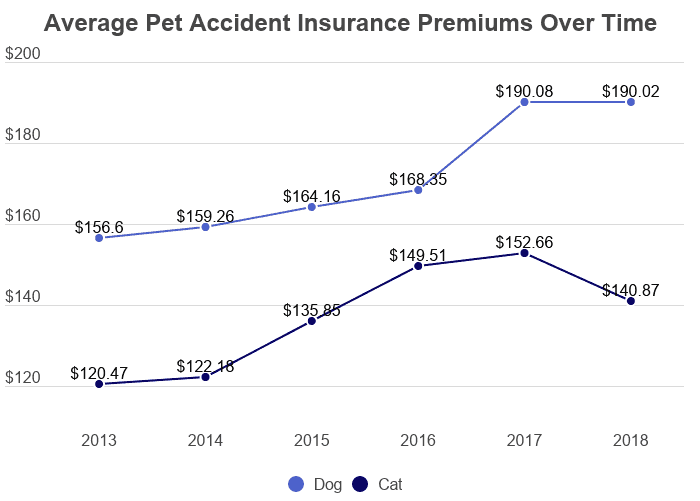
Pet Healthcare
Pet health is the second-greatest expense to pet owners after their animals' food. In general, mixed-brood animals have fewer wellness problems than purebreds. Some breeds are less prone to health problems than others. Some organizations, such as the Humane Society, help pet owners fund unexpected healthcare expenses.
- Some owners report spending more on their pet's medical expenses than they do on their ain healthcare costs.
- On average, canis familiaris owners have their dogs to a veterinarian 2.7 times per twelvemonth.
- Bird owners take their pets to come across a veterinary the about, with an boilerplate of iii.1 vet visits per year.
- Surgery is the most expensive veterinary cost, averaging $474 for dogs, $245 for cats, and $75 for birds.
- Routine veterinary appointments cost an average of $75 more than for dogs than they exercise for cats.
- An emergency veterinarian visit costs canis familiaris owners $349 and cat owners $154 on average.
|
|
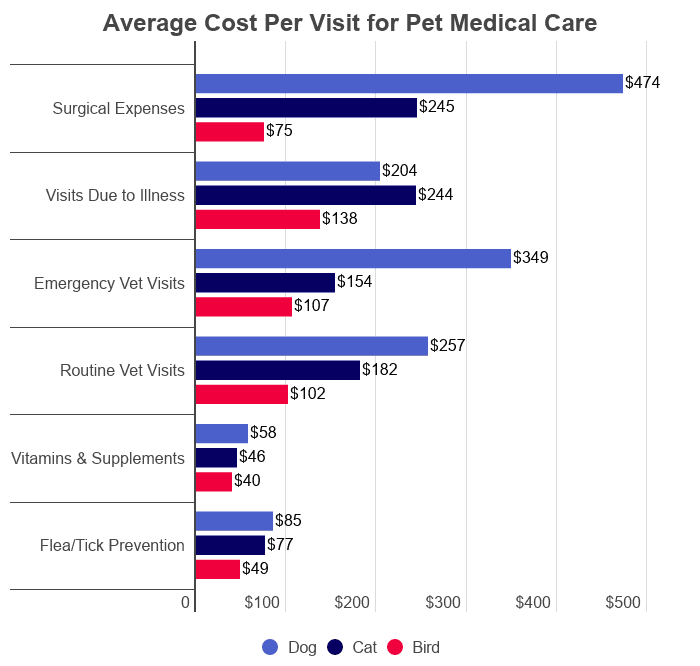
Marijuana Toxicity in Dogs
THC, the "high"-inducing component of marijuana, is toxic to dogs. The substance is particularly harmful in edible form and may be deadly. This fact little-known fact becomes more relavant with the increasing number of locales decriminalizing marijuana. The American Veterinary Medical Association recommends dog owners who fume marijuana do so abroad from their pets and keep their supplies locked safely abroad.
- 33 states take legalized medical marijuana.
- 11 of thos e states accept as well legalized recreational marijuana.
- If dogs ingest THC, they may exhibit the following symptoms:
- Vomiting
- Seizures
- Drowsiness
- Low
- Low Claret Pressure
- Low Body Temperature
- Loss of Coordination
- Excitability
Benefits of Pet Ownership
Medical and healthcare professionals endorse the benefits of animal companionship. Cuddling a dog or a cat is therapeutic. Aquarium fish have a calming effect. These are conclusions derived from scientific and longitudinal studies conducted or endorsed past academic, regulatory, and federal institutions.
- Pet ownership correlates with reduced blood force per unit area.
- Cholesterol and trigliceride levels are lower in pet owners compared to the general population.
- Pet owners engage in more concrete action and practice than the average person.
- Companion animals and animal therapy help with depression and feet direction.
- Anecdotal evidence shows pets reduce feelings of loneliness and increase socialization with other humans.
- Observation of aquarium fish, in addition to easing feet, appears to reduce perception of pain.
- Enquiry also indicates the relaxing effect of aquarium fish may limit hyperactivity in children.
Aquarium Therapy for Alzheimer's
A written report at Purdue University concluded that daily exposure to an aquarium eases symptoms of Alzheimer's. Patients who spent time daily observing aquarium fish experienced improvements in quality of life compared to Alzheimer'south sufferers who did non spend 30 minutes each day with a fish tank.
- Aquarium fish improve cognitive function in Alzheimer'south patients, helping them stay more rational and mentally alert.
- Aquariums influence Alzheimer's patients to eat up to 21% more nutrient, with an boilerplate 17.2% increment in consumption.
- Researchers observed a decrease in the overall number and duration of instances of violence, wandering, pacing, and yelling.
- Reserachers also observed increased verbalization in patients, also as improvements in short-term and long-term memory.
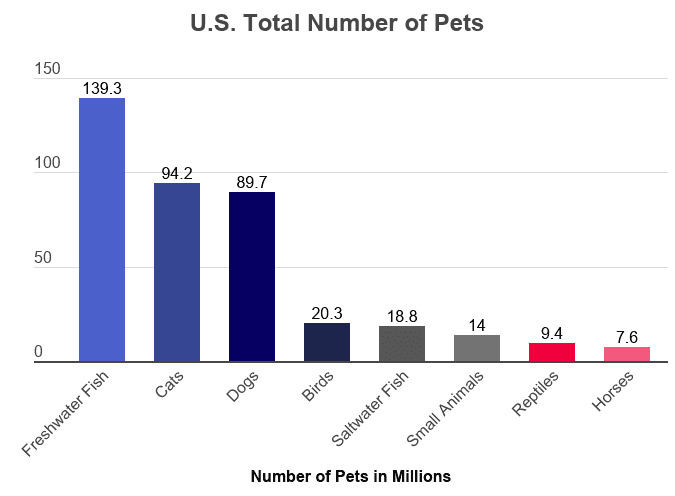
Pet Population Statistics
These numbers for the current full pet population do non include customs pets. What qualifies an animate being such as a equus caballus equally a pet versus a working beast is simply being identified every bit such.
- 393.3 1000000 pets alive in the U.s..
- 139.3 million freshwater fish are kept as pets, more than any other type of animal.
- 94.2 million pet cats live in the United States.
- 89.7 meg dogs are kept as pets.
- 20.3 million pet birds live in the U.S.
- 18.8 1000000 saltwater fish are kept equally pets.
- 9.4 1000000 reptiles are kept.
- 7.6 meg horses are kept.
- xiv million other types of minor animals are pets.
Sources
- Insurance Information Institute, Facts + Statistics: Pet Statistics.
- The Centers for Affliction Control and Prevention (CDC), Good for you Pets, Healthy People.
- Forbes, "Pop Exotic Pets."
- CheatSheet, "Pets That Are Illegal to Keep in the U.S."
- Cuteness, "Tin You Legally Ain a Fennec Fox?"
- American Veterinary Medical Association, "With Legalization on the Ascent, Veterinarians Warn Confronting Pets Getting Into Pot."
- Pet Life Today, "The Country of Pet Healthcare 2019: Guide to Pet Wellness, How Much Americans Spend, Common Illnesses, Treatment Tips, Financial Assist Options and More (With Infographic)."
- Business Insider, "Illinois Just Became the First State to Legalize Marijuana Sales Through the Legislature–Hither Are All united states Where Marijuana is Legal."
- Consumer Reports, "Is Pet Insurance Worth the Cost?"
- The Washington Post, "Is Pet Insurance Worth It?"
- American Pet Products Clan (APPA), Pet Manufacture Marketplace Size & Ownership Statistics
- APPA, Generational Written report Volume 2: Findings
- Animal Sheltering, Pets Past the Numbers
- Western Journal of Nursing Research, Animate being-Assisted Therapy and Nutrition in Alzheimer's Patients
- Millennials Put Pets Outset When Buying a Home
- United States Census Bureau, QuickFacts
- Pet Ownership Statistics by State 2020
- Printing Democrat, California Lags Behind Much of U.S. in Pet Buying
- St. Louis Post-Dispatch, Missouri Makes Height x in Dog Buying
- What are the Healthiest Breeds of Canine Companions?
- Hawaii Humane Lodge, Pets in Housing
greenalacertut1954.blogspot.com
Source: https://spots.com/pet-ownership-statistics/
0 Response to "Small Animals Are Companions to What Percentage of American Families?"
Post a Comment